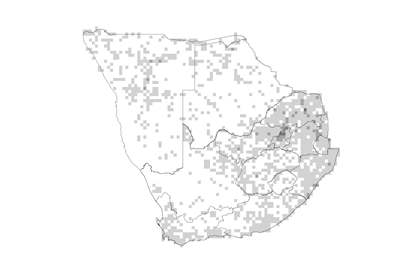 Species distribution and density. Darker squares represent higher density of members of this family. |
Introduction
(including Cuscuta)Morning glory family
The common name, morning glory, is very appropriate for this family. In the mornings the flowers are conspicuous and striking, but they soon fade in the heat of the day and one will often find only wilted closed flowers in the afternoon. In alternative classifications Cuscuta (dodder) is placed in its own family.
Distribution
This cosmopolitan family has a higher concentration of species in the warmer regions of the world. The highest density of species in southern Africa is found in the northeastern region.
Number of genera in the world
� 62
Number of species in the world
� 1 700
Number of genera in the Flora of southern Africa region
16
Number of species in the Flora of southern Africa region
115
Well-known southern African genera
Convolvulus, Cuscuta, Evolvulus, Ipomoea, Merremia
Growth forms
Shrubs or herbs, usually with long, trailing or twining stems, or leafless parasitic herbs.
Habitats
In temperate and tropical regions of the world, dry Mediterranean and semi-desert climates and disturbed areas.
Flagship species
Ipomoea ommanneyi (beespatat [A]) is a vigorous grower with numerous stems growing in all directions from a large tuberous taproot. Young stems grow very quickly outwards and bear large sword-shaped, densely hairy leaves, which stand upright and often face in the same direction. Flowers are pink. The roots are used medicinally to treat convulsions or as an aphrodisiac. Traditionally used by Zulu people in times of famine, often mixed with curdled milk to increase its bulk. This species is widespread in the northern provinces of South Africa and can also be found further north.
Significance of the family
Leaves and starchy tuberous roots of some species are eaten (e.g. sweet potato and water spinach) and are very good and versatile food sources. Some members are well known as showy garden plants, e.g. *Convolvulus cneorum (silver bush), *Ipomoea purpurea (common morning glory), *I. quamoclit (Cypress vine) and *Stictocardia beraviensis (Madagascar convolvulus).
Diagnostic characters
Shrubs or climbing herbs with long thin trailing stems ; milky latex often present . Leaves alternate, lobed or heart-shaped . Flowers trumpet-shaped with 5 fused petals and distinct pleats in the corolla ; petals are twisted in the bud ; 5 stamens, fused to base of flower; ovary superior. Fruit mostly a 4-seeded capsule .
Did you know?
Ipomoea pes-caprae (dune morning glory; sandpatat [A]), commonly found along our beaches, helps to stabilise the sand dunes.